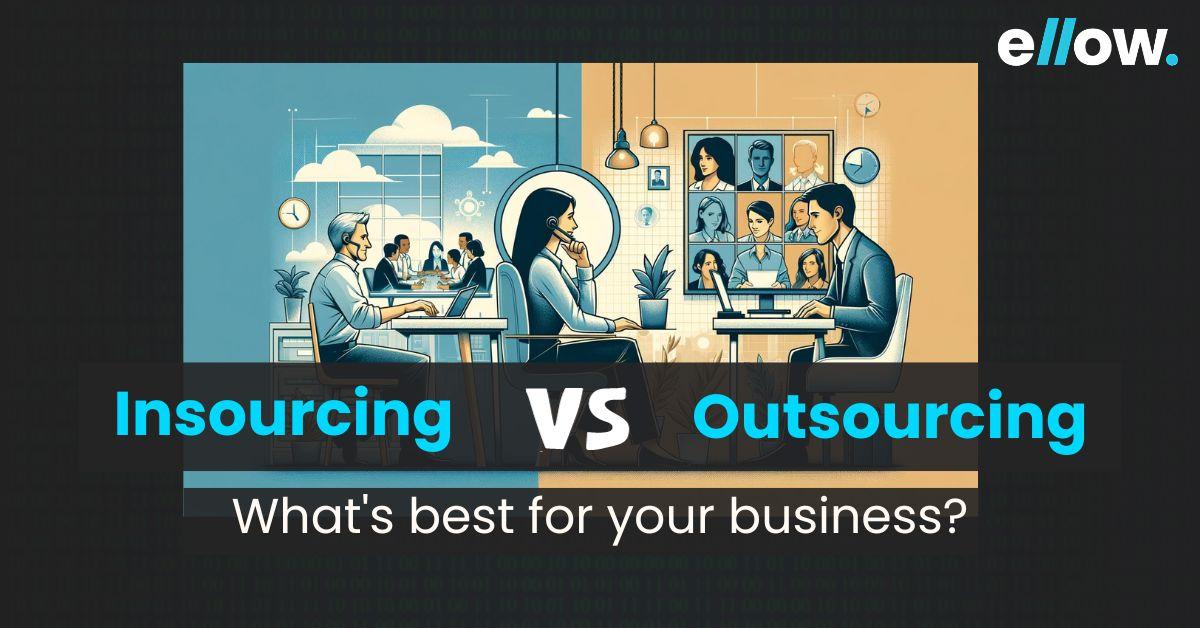Let’s build the future together.
Great ideas need great people. Partner with us to bring your vision to life, or take the first step in your career by joining our team of innovators.

In today’s rapidly growing digital economy, the dynamics of work have undergone a shift, presenting businesses with a crucial decision: insourcing versus outsourcing.
As the internet continues to reshape our approach to work, the PWC survey highlights that 61% of CEOs anticipate a more digital future for their business models. Amidst this transformative landscape, the question of whether to outsource or insource has become increasingly complex.
What are the implications, and which path is more advantageous for your business?
This article delves into the strategic decision-making process, comprehensively exploring the pros and cons associated with outsourcing and insourcing. By examining the intricacies of each approach, we aim to empower you with the insights needed to make an informed choice that aligns with the unique needs and goals of your business in the digital era.
Tech outsourcing refers to the practice of hiring an external entity or individual, such as a contracting firm or freelancer, to handle specific technology-related tasks or projects. Instead of relying solely on in-house resources, businesses can delegate certain tech responsibilities to external professionals.
This approach allows companies to access specialized skills, save time, and often reduce costs associated with recruiting and maintaining a full-time, in-house tech team. Tech outsourcing can involve a range of services, from software development and IT support to web design and other technical tasks.
It is a flexible strategy that enables businesses to efficiently meet their technology needs by leveraging external expertise and resources.
Check this video out:
Opting for an outsourcing business model has several advantages tailored to its efficiency and cost-effectiveness. Some key benefits include:
Despite its benefits, outsourcing is not without potential drawbacks. Some notable disadvantages include:
Insourcing is the practice of bringing a specific task or function within a company’s operations and handling it internally rather than outsourcing it to external parties. In simple terms, insourcing means doing the work in-house with the organization’s resources.
When considering insourcing versus outsourcing, cost plays a pivotal role. Insourcing, utilizing internal resources, may be cost-effective if expertise is readily available. In contrast, outsourcing involves payments to external providers, often reducing expenses. The choice depends on the company’s financial structure and the availability of skilled in-house resources.
Insourcing relies on the internal team’s expertise, which can vary based on their skills. In contrast, outsourcing often ensures higher quality, as specialized external providers bring focused proficiency to tasks.
This is particularly evident when collaborating with companies like ellow, dedicated to specific services. ellow, exemplifies the benefits of outsourcing by connecting businesses with the top 3% of freelance developers. Their rigorous AI + Human-based vetting process ensures that companies receive highly skilled professionals, tailored to their specific industry needs.
Insourcing often leads to longer timelines due to internal constraints, whereas outsourcing with partners like ellow accelerates project completion. ellow enables companies to hire pre-vetted remote software talent within just 48 hours, offering a quick, efficient solution for urgent projects. This highlights the efficiency of outsourcing in balancing speed and expertise.
In deciding between insourcing and outsourcing, the level of control is pivotal. Insourcing grants greater influence over project management and outcomes, vital for meticulous supervision. Conversely, outsourcing relinquishes some control, relying on external partners. The choice hinges on the desired balance between autonomy and external collaboration.
Insourcing carries more risk if internal resources lack the required skills. In contrast, outsourcing involves lower risk as the responsibility for the work lies with an external provider. However, there is a potential risk of compromised quality if the chosen outsourcing partner is not reliable or does not meet expected standards.
Consider your company’s values and work environment. If your culture prioritizes control and quality, insourcing may align better. In contrast, if efficiency and speed are paramount, outsourcing could be more suitable. The decision should harmonize with your company’s ethos to promote a cohesive and successful work environment.
Concerns over intellectual property (IP) safety may influence the choice between insourcing and outsourcing. While insourcing might seem more secure, outsourcing can be equally safe with legally-binding contracts. Remote work is increasingly common, challenging the notion that physical presence guarantees IP protection, making contractual arrangements a viable safeguard for both approaches.
1. When Cost-Effectiveness is a Priority: A business might choose outsourcing when it’s looking to reduce operational costs. Outsourcing tasks such as customer service or IT support to regions with lower labor costs can provide significant savings while maintaining quality.
2. When Maintaining Control is Critical: A business should choose insourcing when tasks are integral to its core operations or when confidentiality is paramount. For example, a financial institution might insource its risk management to ensure stringent control over sensitive data.
3. When Specialized Skills are Required Temporarily: If a business needs specialized skills for a short-term project, outsourcing is the right choice. For instance, hiring a third-party marketing agency for a one-time campaign allows access to expert skills without long-term commitment.
4. When Quality Standards are High: Businesses with high-quality standards might prefer insourcing to maintain control over every aspect of the production or service delivery process. Luxury brands often insource manufacturing to ensure top-notch quality.
5. When Core Business Needs Focus: A company might opt for outsourcing when it needs to concentrate on its core competencies. Outsourcing peripheral tasks like administrative duties allows the business to focus on its primary products or services.
6. When Scalability is Essential: Businesses needing to scale up or down quickly might find outsourcing beneficial. For instance, e-commerce businesses may outsource logistics during peak seasons to handle increased demand efficiently.
7. When Building Long-Term Internal Expertise: Insourcing is the right decision when a business aims to build and retain expertise in-house. Tech companies, for instance, might insource R&D to foster innovation and maintain a competitive edge.
8. When Long-Term Cost Savings are Foreseen: If a business predicts that building an internal team will be more cost-effective in the long run, insourcing is the appropriate choice. This is often the case for large companies that can afford to invest in developing comprehensive in-house teams.
Identifying an excellent outsourcing service provider is crucial for the success of your business. To make this process simpler, follow these steps:
Begin by ensuring that the outsourcing service provider has a good reputation. Research their background and inquire about their reputation from reliable sources. A trustworthy way to do this is by contacting references. Ask these references about their experiences working with the provider. Were they satisfied with the quality of work? Did the provider respond promptly to their needs?
Ask the outsource provider for a list of past and current clients. Reach out to these clients to gain firsthand insights into their experiences. Their feedback will provide valuable information about the provider’s reliability, professionalism, and the overall quality of their services.
Make sure the outsource provider can meet your specific requirements. If you need assistance with website development, for example, confirm that the provider has relevant experience in this field. Tailoring your selection to match your unique needs ensures a better fit and higher satisfaction.
Verify that the outsourcing provider can meet your deadlines and operate within your budget constraints. This is crucial for maintaining a smooth workflow and avoiding unexpected financial strain. A reliable provider will communicate clearly about project timelines and costs, ensuring a transparent and efficient partnership.
If you are considering a specific provider like Ellow.io, explore the range of services they offer. At Ellow, we aim to streamline and optimize the process of remote hiring. With us, you can confidently hire pre-vetted remote software talent within just 48 hours, saving you valuable time and resources.
As per a recent study by Grand View Research, the anticipated size of the global recruitment process outsourcing market is projected to reach USD 20.8 billion by the year 2027.
Ultimately, the key lies in a thoughtful evaluation of your business requirements and a careful consideration of the trade-offs involved. By weighing the pros and cons and asking yourself pertinent questions about your company’s priorities, you can make an informed decision that aligns with the goals and values of your business.
Software Development Outsourcing: A Ultimate Guide
10 Leading Companies Who Outsource
What is Recruitment Process Outsourcing (RPO)?
Consider factors such as cost, control, expertise, and the nature of your business operations. Assess how each option aligns with your company’s specific needs and strategic goals.
Outsourcing can often lead to cost savings due to lower labor and operational expenses in certain regions. However, the actual cost-effectiveness depends on factors like the industry, location, and the services being outsourced.
While outsourcing involves relinquishing some control, the extent varies. Clearly define expectations and establish communication channels with the outsourcing partner to maintain transparency and control over key aspects of your operations.
Yes, a hybrid approach, combining elements of both outsourcing and insourcing, is possible. Assess which functions are best kept in-house for control and which can be outsourced for efficiency. Finding the right balance is crucial for a customized strategic solution.
Insourcing may involve higher initial investment and operational costs. Risks include resource constraints and adapting to fluctuations in demand. Mitigate these risks through effective resource planning, scalability considerations, and a thorough understanding of your business’s long-term needs.

How Top SaaS Companies Build Agile Teams with Remote Developers

How to Hire Vetted Remote Developers in a Hyper-Competitive Market

Top 5 Countries to Hire Remote Developers (and Why)
Please feel free to share your thoughts and we can discuss it over a cup of tea.
Get a quote
How Top SaaS Companies Build Agile Teams with Remote Developers

Six Things to Consider When Hiring Remote Talent

ellow.io enters remote hires market with AI-based screening process